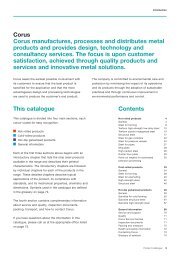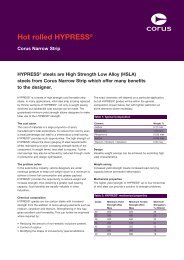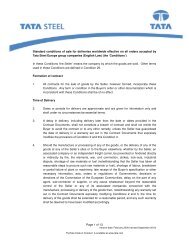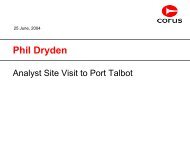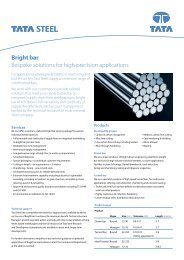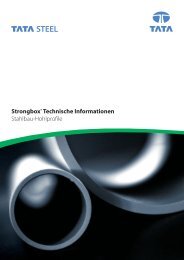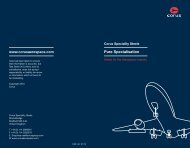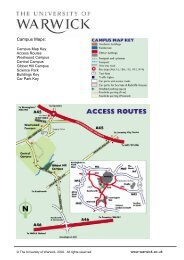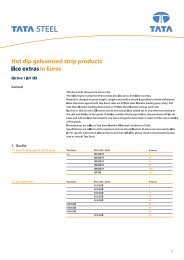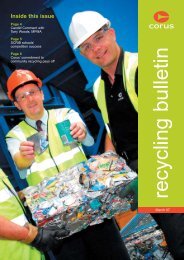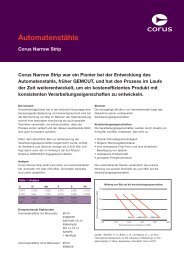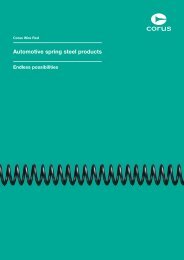Corporate responsibility report 2004 - Tata Steel
Corporate responsibility report 2004 - Tata Steel
Corporate responsibility report 2004 - Tata Steel
Create successful ePaper yourself
Turn your PDF publications into a flip-book with our unique Google optimized e-Paper software.
Environment<br />
met in the areas around all of our<br />
major facilities, with the exception<br />
of PM10s in the Port Talbot area,<br />
where we are continuing to work very<br />
closely with the authorities to better<br />
understand our contribution to<br />
the problem.<br />
We are committed to reducing<br />
our impact as far as is practicable<br />
and cost-effective. We invested<br />
£312m (€468m) in <strong>2004</strong>, of which<br />
approximately 10% was related<br />
to environmental improvements.<br />
For example:<br />
• At our primary aluminium smelter in<br />
Delfzijl, we reduced fluoride emissions<br />
from an average of 97 tonnes per year<br />
to 73 tonnes in <strong>2004</strong>.<br />
• At Corus Tubes, Hartlepool,<br />
investment in a new pipe-coating<br />
process has led to a six-fold<br />
reduction in organic solvent<br />
emissions between 2000 and <strong>2004</strong>.<br />
We have established a significant<br />
programme of research and<br />
development, both to improve our<br />
understanding of our emissions and<br />
to develop new emissions control<br />
technology. Some examples of our<br />
achievements during <strong>2004</strong> are<br />
described in the case study on<br />
page 25.<br />
Figure 8 Emissions to air relative to 1999<br />
(per tonne of steel unless otherwise stated)<br />
110<br />
100<br />
90<br />
80<br />
70<br />
60<br />
1999 2000 2001 2002 2003 <strong>2004</strong><br />
CO 2<br />
Particulates<br />
Dioxins<br />
SO 2<br />
NO X<br />
Fluorides/tonne aluminium<br />
We have set ourselves a target to<br />
identify and assess our contribution<br />
to ambient air concentrations of<br />
fine and ultrafine dust particles<br />
(PM2.5s and PM0.1s). To this end,<br />
we are the lead organisation in a<br />
multi-partner European research<br />
project that aims to quantify fine and<br />
ultrafine emissions from previously<br />
unmeasured sources using new<br />
measurement methodologies.<br />
The effect of our improvements in<br />
emissions control can be seen in<br />
Table 1, which compares emissions<br />
in <strong>2004</strong> with those in 1999. Figure 8<br />
presents normalised emissions data<br />
for our most significant releases to<br />
air from 1999 to <strong>2004</strong>.<br />
Table 1 Releases to air – Corus Group<br />
(tonnes/year unless otherwise stated)<br />
Substance 1999 <strong>2004</strong><br />
CO 2 * 32,500,000 29,200,000<br />
PFCs 12.3 10.6<br />
Particulates 18,500 12,200<br />
PM10s no data 5,900<br />
Dioxins 45g 29g<br />
PAHs 7.5 4.0<br />
Benzene 130 60<br />
NMVOCs 1,700 1,200<br />
NO x 32,500 25,900<br />
SO 2 40,000 28,400<br />
CO 552,000 317,000<br />
Fluorides 206 150<br />
Arsenic 0.76 0.28<br />
Cadmium 1.03 1.12**<br />
Chromium 6.3 2.7<br />
Copper 5.4 3.7<br />
Lead 78.9 63.0<br />
Mercury 0.43 0.46**<br />
Zinc 93.9 36.6<br />
*Not comparable to EU ETS allocations –<br />
different <strong>report</strong>ing scope.<br />
**The apparent increase compared to 1999<br />
for mercury and cadmium is due to improved<br />
monitoring and extended <strong>report</strong>ing.<br />
Our aluminium production plant in Duffel.<br />
<strong>Corporate</strong> <strong>responsibility</strong> <strong>report</strong> 21




